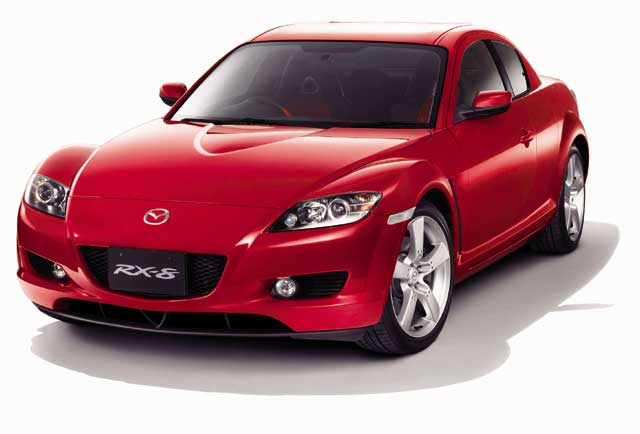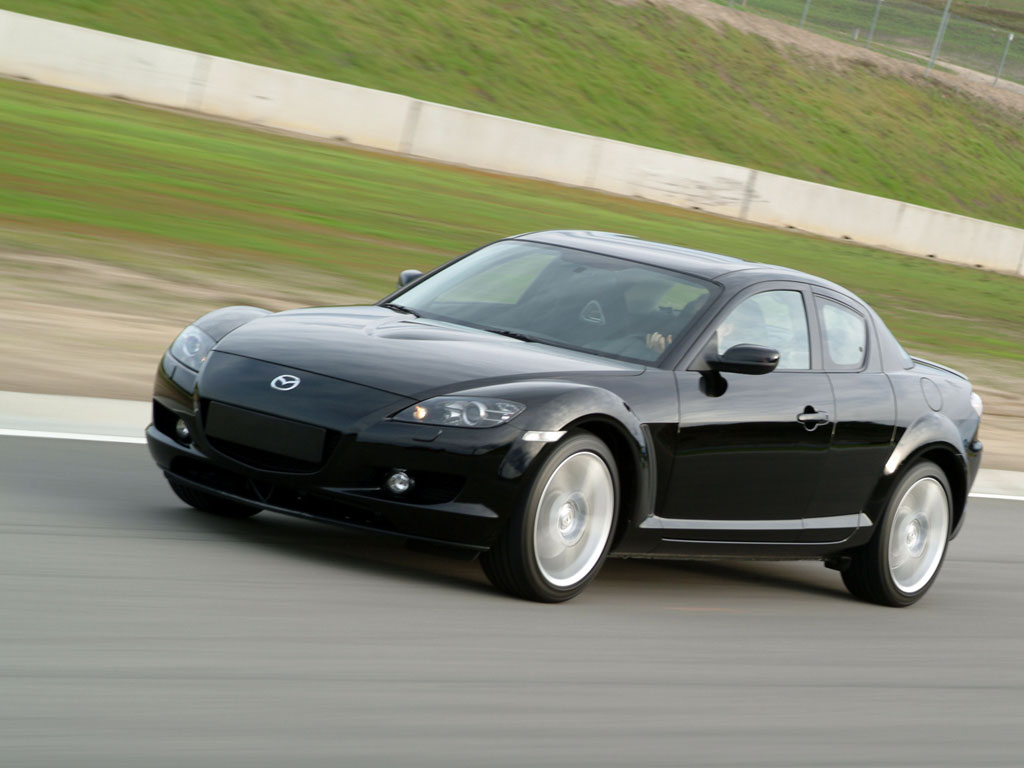Mazda RX8
The Mazda RX-8 is a sports car manufactured by Mazda Motor Corporation. It first appeared in 2001 at the North American International Auto Show. It is the successor to the RX-7 and, like its predecessors in the RX range, it is powered by a Wankel engine. The RX-8 began North American sales in the 2004 model year.Background
Mazda introduced rotary engine vehicles in the US in 1971, beginning with the R100, followed by RX-2, RX-3, RX-4, RX-5, and finally three generations of the RX-7 sports car. However, the lack of creature comfort and user-friendliness, coupled with the high price tag and declining interest in sports cars and coupes at this time, led Mazda to pull the RX-7 from most major markets except Japan. After 1995, Mazda suffered from a relatively undistinguished product line in the US save the MX-5 Miata. As popular interest in import tuning and performance cars resurged in the late-1990s, thanks in part to various popular cultural influences such as the Sony PlayStation video game Gran Turismo[citation needed], Japanese automakers waded back into the performance and sports car market in the US. In addition, Mazda endeavored to rejuvenate itself around this time, partially with financial and management assistance from Ford, and successfully developed a new product line of high quality cars with desirable styling and superior driving dynamics, beginning with the Mazda6 and followed by the Mazda3, paving way for the arrival for Mazda's next-generation rotary sportsDevelopment and design
Development of the RX-8 can be traced to as far back as the 1995 Mazda RX-01 concept car, which featured an early iteration of the 13B-MSP engine. Naturally aspirated with side exhaust ports, this engine produced 220 hp (160 kW). As prohibited by Mazda's financial state at the time and the growing market interest in SUVs, the RX-01 never saw further development or production. However, a "skunkworks project" engineering team within Mazda kept the development of the 13B-MSP alive using MX-5 Miata chassis, eventually catching the attention of management, which at this time had come under heavy influence from Ford. Development of the 13B-MSP advanced and eventually led to the RENESIS moniker debuting along with the RX-EVOLV concept car which began to bear semblance to the production RX-8 with the "freestyle" rear suicide doors. Styling was developed via design competitions in Mazda tradition among its design studios in Japan, the US, and Europe. The project obtained official approval from management, and eventually the RX-8 concept car (design/engineering model) was produced and shown in 2001, closer resembling the production version. A near-production "reference exhibit" RX-8 was shown shortly thereafter at the 2001 Tokyo Motor Show, pending final approval for production. Production RX-8 closely resembles this vehicle save for minor trim details, and "job 1" began in February 2003 at Mazda's Hiroshima plant in Japan.The RX-8 was designed as a front mid-engine, rear-wheel drive four-seat four-door coupé. The car has 52:48 front-rear weight distribution, and a low Polar Moment that is achieved by mounting the engine behind the front axle and the fuel tank ahead of the rear axle. The front wheels feature classic independent double wishbone suspension, while the rear are independent multi-link. Weight is trimmed through the use of materials such as aluminium and plastic for several body panels. The rest of the body is steel, save for the plastic front and rear bumpers. The manual gearbox model uses a carbon fiber composite driveshaft to reduce the rotational mass (moment of inertia) connected to the engine. Power is sent to the rear wheels via a Torsen limited slip differential for improved handling. While its not quite in the league as the last RX-7 in terms of raw performance, the RX-8 is considered its successor as Mazda's rotary engine sports car. Its layout and clever engineering, along with typical Mazda suspension tuning, have endowed it with excellent driving dynamics which have garnered much praise and numerous awards. It has also proven popular in Japan among car enthusiasts as well as aftermarket equipment manufacturers and professional tuners.
A prominent feature of the RX-8 is a pair of rear-hinged "freestyle" doors (similar to suicide doors) in order to provide easier access to the rear seats. The RX-8 has no B-pillar between the front and rear doors, with the leading edge of the rear door acting as a "virtual pillar" to maintain structural rigidity. Because of the overlapping design, the rear doors can be opened only when the front doors are open. Although by no means expansive, the RX-8's cabin was designed to allow enough room to house four adults, making it a genuine 4-seater rather than a 2+2.
The RX-8 was sold on exports markets including in Europe, whereas the RX-7 had been withdrawn from these markets after 1996 due to falling sales and thereafter only sold in Japan.
(SE3P) 2003 - 2008
The first version of the RX-8, chassis code SE3P, and JMZSE, was produced from model year 2006. It is powered by the RENESIS 13B-MSP (multi side port) Wankel 654x2 rotary engine displacing 1.3 litres non-turbo (1308 cc). At launch, the RENESIS was available in standard and high power versions. The 4-port standard RENESIS produced 210 hp (160 kW) and was coupled with either a 5-speed manual or 4-speed automatic transmission. The 6-port high power RENESIS was only available with a six-speed manual transmission and was rated at 250 hp (190 kW). For the North American market, Mazda revised the reported output rating of the standard and high power RENESIS soon after launch to 197 hp (147 kW) and 238 hp (177 kW), respectively. With exhaust ports now located in the side housing, the RENESIS boasted improved fuel efficiency and emissions rating over the 13B-REW employed by the last RX-7, thereby making it possible to be sold in North America.At launch, the RX-8 was available in various models in different markets around the world. Standard models include:
- 6-speed manual "High Power" with a claimed output of 184 kW (250 PS; 247 hp) and a 9,000 rpm redline (Sold in North America). This model was equivalent to the "Type S" trim in Japan.
- 5-speed manual "Standard Power" tuned to 141 kW (192 PS; 189 hp) with the redline reduced to 7,500 rpm. This powertrain combination was not available in North America.
- 4-speed automatic tuned to 141 kW (192 PS; 189 hp) in some markets (NZ), while the U.S. automatic is stated to deliver 158 kW (215 PS; 212 hp) .
- 6-speed automatic (available in the U.S. market after 2006) developing 158 kW (215 PS; 212 hp) and 159 lb•ft (216 N•m) of torque with a redline at 7,500 rpm. This was the revised standard RENESIS, now with two extra intake ports like the high power version.
Shinka
In 2005, Mazda introduced the first special edition RX-8 called "Sports Prestige Limited" in Japan and "Shinka" in North America. Billed as a more luxurious grand touring model, this Shinka came with Black Cherry exterior color and Parchment leather interior along with subtly chromed 18" wheels. Only 1357 were made in the 2005 model year (though 2150 were scheduled, production never reached that amount). The most significant mechanical change were slightly revised Bilstein shocks and suspension cross member injected with urethane foam to improve ride quality.Shinka returned for 2006 as a production trim package, now available in Copper Red, Galaxy Grey, and Whitewater Pearl. Only 1500 were made in 2006.










Tidak ada komentar:
Posting Komentar